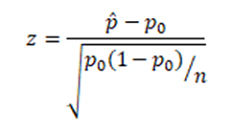-
(+44) 20 3287 0255
Call us for enquiry -
Connect On Whatsapp (+44) 1618187774
Uninterrupted Access 24x7, 100% Confidential. - Connect Now

Statistics are very complicated, hence people depends on the data analysis and thus performs tests. There are multiple parameters that you can test. Like, for z-test (paired-sample-test), it is a test for the mean. The one proportion test is commonly done to confirm or debunk claims. Test for the population proportion is denoted as p. The only thing you need to do is take a random sample of components and use one proportion test to determine that the actual proportion backs up the claim. For example, you want to know the proportion of males within a total population of adults. Here test of proportion helps you assess whether the sample represents the true proportion from the entire population or not. There are a few things that needed to be defined first before conducting the proportion test.

This test is performed to compare an observed proportion to a theoretical one when there are only two categories. Based on the sample size, normal approximation or binomial enumeration is done. If the sample size is large, the normal approximation provides an accurate result. If the sample size is less, then binomial enumeration gives the correct results. The binomial enumeration and normal approximation can be approximated when both mean (np) and variance( n(1-p)) values are greater than 10.
R functions: binom.test() & prop.test()
The syntax of the two functions are the same. The simplified format is as follow:
binom.test(x, n, p = 0.5, alternative = "two.sided")
prop.test(x, n, p = NULL, alternative = "two.sided",
correct = TRUE)